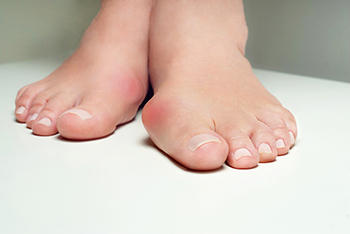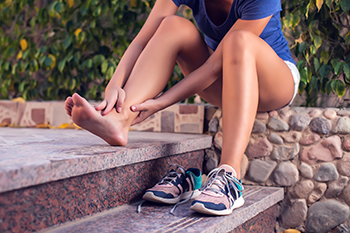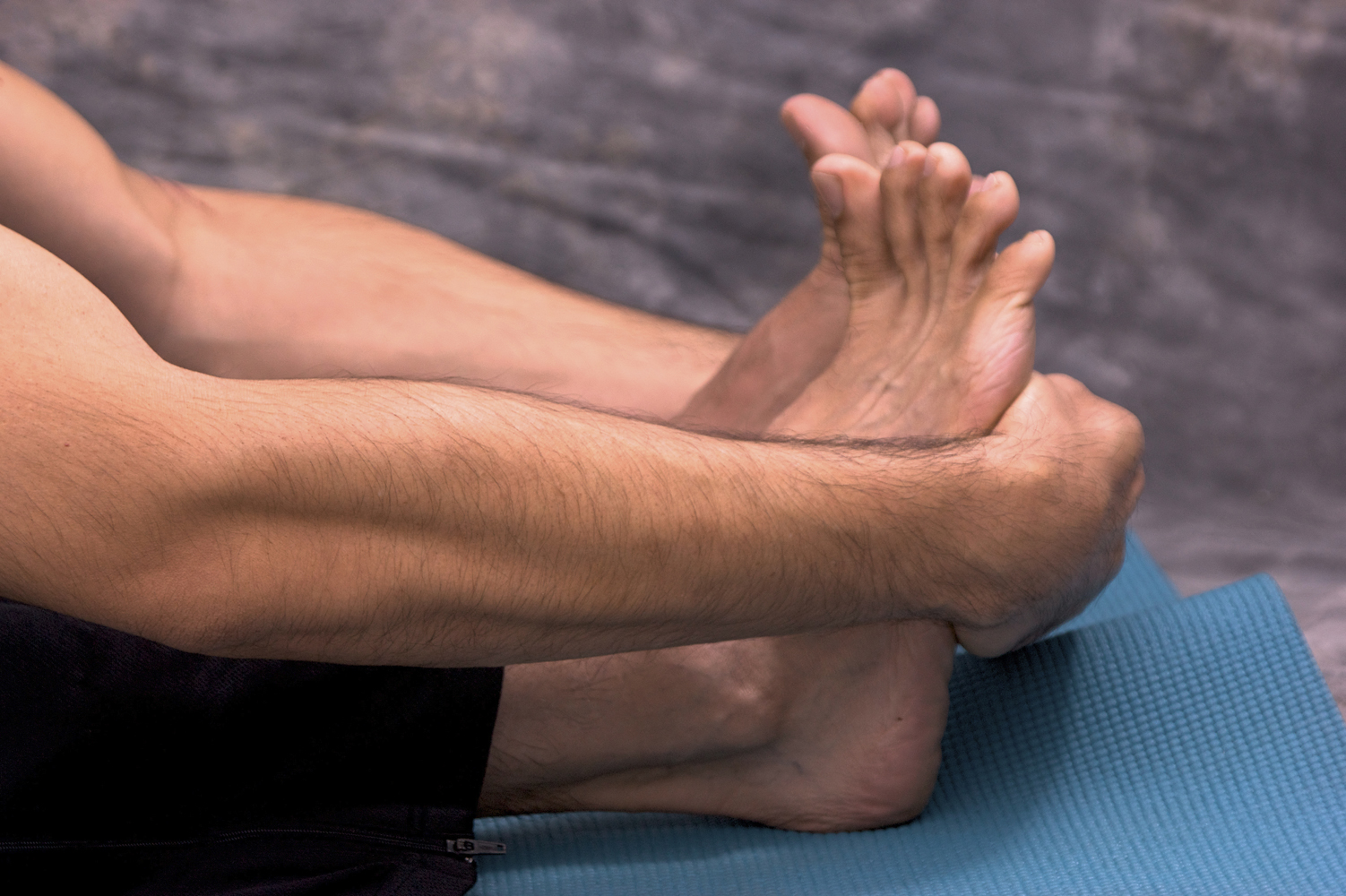Connect With Us
Blog
Items filtered by date: August 2023
Bunion Facts

Bunions are a common foot deformity that can affect both men and women, although they are more prevalent in women who wear narrow-toed shoes. This condition involves the displacement of the joint connecting the big toe and the first metatarsal bone, causing the joint to protrude on the inner side of the foot and the big toe to deviate toward the smaller toes. Several factors contribute to the development of bunions. Genetics may play a role, as there can be a family tendency for this deformity. Abnormal foot mechanics, such as overpronation, where the foot flattens excessively and turns outward during walking, can contribute to bunion formation. Wearing tight, high-heeled shoes can worsen the condition, leading to pain due to shoe pressure and altered weight distribution. Treatment options may include medication for pain relief, protective measures to reduce pressure on the area, and orthotic devices to correct abnormal gait and prevent further deformity. In cases where deformity is severe and conservative treatments are ineffective, surgical intervention may be necessary. If you have a bunion and it is causing discomfort, it is suggested that you make an appointment with a podiatrist who can examine your foot and recommend the most suitable treatment plan.
If you are suffering from bunions, contact Matthew Fillipi, DPM of Practice. Our doctor can provide the care you need to keep you pain-free and on your feet.
What Is a Bunion?
A bunion is formed of swollen tissue or an enlargement of boney growth, usually located at the base joint of the toe that connects to the foot. The swelling occurs due to the bones in the big toe shifting inward, which impacts the other toes of the foot. This causes the area around the base of the big toe to become inflamed and painful.
Why Do Bunions Form?
Genetics – Susceptibility to bunions are often hereditary
Stress on the feet – Poorly fitted and uncomfortable footwear that places stress on feet, such as heels, can worsen existing bunions
How Are Bunions Diagnosed?
Doctors often perform two tests – blood tests and x-rays – when trying to diagnose bunions, especially in the early stages of development. Blood tests help determine if the foot pain is being caused by something else, such as arthritis, while x-rays provide a clear picture of your bone structure to your doctor.
How Are Bunions Treated?
- Refrain from wearing heels or similar shoes that cause discomfort
- Select wider shoes that can provide more comfort and reduce pain
- Anti-inflammatory and pain management drugs
- Orthotics or foot inserts
- Surgery
If you have any questions, please feel free to contact our office located in East Longmeadow, MA . We offer the newest diagnostic and treatment technologies for all your foot care needs.
Causes of Swollen Ankles After Running

Swollen ankles after running can be a concerning and uncomfortable issue that many athletes and runners experience. While it's essential to push your limits and stay active, it's equally important to recognize the potential causes of this discomfort. One common cause of swollen ankles after running is improper footwear. Ill-fitting shoes or those lacking proper support can lead to strain on the ankles, resulting in inflammation. Overuse and overtraining can also contribute to swelling. Pushing yourself too hard or abruptly increasing your running intensity can cause stress on the ankle joints and surrounding tissues, leading to swelling. Further, inadequate warm-up and cool-down routines can lead to muscle tightness and cause fluid to accumulate around the ankles. Proper running shoes, a gradual training progression, and thorough warm-up and cool-down routines can significantly reduce the risk of swollen ankles. If swelling in the ankles persists or worsens, it is suggested that you make an appointment with a podiatrist to rule out underlying issues like sprains, strains, or ligament damage.
Ankle pain can be caused by a number of problems and may be potentially serious. If you have ankle pain, consult with Matthew Fillipi, DPM from Practice. Our doctor will assess your condition and provide you with quality foot and ankle treatment.
Ankle pain is any condition that causes pain in the ankle. Due to the fact that the ankle consists of tendons, muscles, bones, and ligaments, ankle pain can come from a number of different conditions.
Causes
The most common causes of ankle pain include:
- Types of arthritis (rheumatoid, osteoarthritis, and gout)
- Ankle sprains
- Broken ankles
- Achilles tendinitis
- Achilles tendon rupture
- Stress fractures
- Bursitis
- Tarsal tunnel syndrome
- Plantar fasciitis
Symptoms
Symptoms of ankle injury vary based upon the condition. Pain may include general pain and discomfort, swelling, aching, redness, bruising, burning or stabbing sensations, and/or loss of sensation.
Diagnosis
Due to the wide variety of potential causes of ankle pain, podiatrists will utilize a number of different methods to properly diagnose ankle pain. This can include asking for personal and family medical histories and of any recent injuries. Further diagnosis may include sensation tests, a physical examination, and potentially x-rays or other imaging tests.
Treatment
Just as the range of causes varies widely, so do treatments. Some more common treatments are rest, ice packs, keeping pressure off the foot, orthotics and braces, medication for inflammation and pain, and surgery.
If you have any questions, please feel free to contact our office located in East Longmeadow, MA . We offer the newest diagnostic and treatment technologies for all your foot care needs.
The Heels and Mobility

Various foot conditions can make movement difficult. Chief among them is cracked heels. As one ages, skin becomes thinner and dryer and the skin on the heels can form calluses, or dead skin, and can develop cracks. This often happens because the heels endure a lot of pressure from walking and the skin is dry. Cracked heels can become painful and make walking difficult. If they get bad enough, fissures can develop and the cracks deepen, can bleed, and be a breeding ground for infection. If one has diabetes, peripheral artery disease, or poor circulation, cracked heels can become serious foot wounds that are difficult to heal. Hydration and moisturizing the feet can help with cracked heels, as can wearing socks with cushioned shoes and temporarily cutting down on activities that put pressure on the heels. If you have cracked heels and the condition is causing you discomfort or it is worsening, it is strongly suggested that you make an appointment with a podiatrist who can make sure that is what you are dealing with and provide treatment.
If the skin on your feet starts to crack, you may want to see a podiatrist to find treatment. If you have any concerns, contact Matthew Fillipi, DPM from Practice. Our doctor can provide the care you need to keep you pain-free and on your feet.
Cracked Heels
It is important to moisturize your cracked heels in order to prevent pain, bleeding, and infection. The reason cracked heels form is because the skin on the foot is too dry to support the immense pressure placed on them. When the foot expands, the dry skin on the foot begins to split.
Ways to Help Heal Them
- Invest in a good foot cream
- Try Using Petroleum Jelly
- Ease up on Soaps
- Drink Plenty of Water
Ways to Prevent Cracked Heels
- Moisturize After Showering
- Skip a Shower
- Keep Shower Water Lukewarm
- Don’t Scrub Your Feet
If you are unsure how to proceed in treating cracked heels, seek guidance from a podiatrist. Your doctor will help you with any questions or information you may need.
If you have any questions, please feel free to contact our office located in East Longmeadow, MA . We offer the newest diagnostic and treatment technologies for all your foot care needs.
The Importance of Stretching for Healthy Feet

Stretching plays a vital role in maintaining healthy feet and overall well-being. It offers numerous benefits, such as improved flexibility, better circulation, reduced risk of injury, and less pain. By incorporating a few minutes of stretching into your daily routine, you can experience these advantages. Morning stretches can be instinctive, where your body subconsciously stretches to modify tension in the feet, surrounding muscles, organs, and blood vessels. Sitting or standing for extended periods can lead to muscle tightness and discomfort. Incorporating stretching breaks can help ease tension in the neck, back, hips, legs, and feet. Stretching before bedtime can promote relaxation and improved sleep quality. If you would like more information about specific stretches that will help your feet, it is suggested that you make an appointment with a podiatrist who can provide this type of information.
Stretching the feet is a great way to prevent injuries. If you have any concerns with your feet consult with Matthew Fillipi, DPM from Practice. Our doctor will assess your condition and provide you with quality foot and ankle treatment.
Stretching the Feet
Stretching the muscles in the foot is an important part in any physical activity. Feet that are tight can lead to less flexibility and make you more prone to injury. One of the most common forms of foot pain, plantar fasciitis, can be stretched out to help ease the pain. Stretching can not only ease pain from plantar fasciitis but also prevent it as well. However, it is important to see a podiatrist first if stretching is right for you. Podiatrists can also recommend other ways to stretch your feet. Once you know whether stretching is right for you, here are some excellent stretches you can do.
- Using a foam roller or any cylindrical object (a water bottle or soda can will do), roll the object under your foot back and forth. You should also exert pressure on the object. Be sure to do this to both feet for a minute. Do this exercise three times each.
- Similar to the previous one, take a ball, such as a tennis ball, and roll it under your foot while seated and exert pressure on it.
- Grab a resistance band or towel and take a seat. If you are using a towel, fold it length wise. Next put either one between the ball of your foot and heel and pull with both hands on each side towards you. Hold this for 15 seconds and then switch feet. Do this three times for each foot.
- Finally hold your big toe while crossing one leg over the other. Pull the toe towards you and hold for 15 seconds. Once again do this three times per foot.
It is best to go easy when first stretching your foot and work your way up. If your foot starts hurting, stop exercising and ice and rest the foot. It is advised to then see a podiatrist for help.
If you have any questions, please feel free to contact our office located in East Longmeadow, MA . We offer the newest diagnostic and treatment technologies for all your foot care needs.
Be Mindful Of Your Feet While Wearing Flip-Flops This Summer
Pain or No Pain With Flat Feet

The majority of babies are born with flat feet, and the arch generally develops during childhood years. The arch runs lengthwise along the bottom of the foot, and it may not become developed in adults for various reasons. These may include genetic reasons, or it may not form if an injury has occurred. Additionally, there may be existing medical conditions which may cause flat feet, such as rheumatoid arthritis or diabetes. Many people do not have pain with flat feet, and there are some patients who have pain from wearing shoes that do not fit correctly. There may also be changes in the work environment, which may involve standing on different surfaces. There are specific stretches that can be performed which may help people who have flat feet. A calf stretch can be effective in strengthening the lower part of the leg. This is done by standing on a step and lowering one heel at a time until a gentle stretch is felt. If you have flat feet, it is suggested that you are under the care of a podiatrist who can prescribe custom-made orthotics for relief, if needed.
Flatfoot is a condition many people suffer from. If you have flat feet, contact Matthew Fillipi, DPM from Practice. Our doctor will treat your foot and ankle needs.
What Are Flat Feet?
Flatfoot is a condition in which the arch of the foot is depressed and the sole of the foot is almost completely in contact with the ground. About 20-30% of the population generally has flat feet because their arches never formed during growth.
Conditions & Problems:
Having flat feet makes it difficult to run or walk because of the stress placed on the ankles.
Alignment – The general alignment of your legs can be disrupted, because the ankles move inward which can cause major discomfort.
Knees – If you have complications with your knees, flat feet can be a contributor to arthritis in that area.
Symptoms
- Pain around the heel or arch area
- Trouble standing on the tip toe
- Swelling around the inside of the ankle
- Flat look to one or both feet
- Having your shoes feel uneven when worn
Treatment
If you are experiencing pain and stress on the foot you may weaken the posterior tibial tendon, which runs around the inside of the ankle.
If you have any questions please feel free to contact our office located in East Longmeadow, MA . We offer the newest diagnostic and treatment technologies for all your foot and ankle needs.




